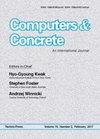A new formulation for strength characteristics of steel slag aggregate concrete using an artificial intelligence-based approach
IF 2.9
4区 工程技术
Q2 COMPUTER SCIENCE, INTERDISCIPLINARY APPLICATIONS
引用次数: 2
Abstract
Steel slag, an industrial reject from the steel rolling process, has been identified as one of the suitable, environmentally friendly materials for concrete production. Given that the coarse aggregate portion represents about 70% of concrete constituents, other economic approaches have been found in the use of alternative materials such as steel slag in concrete. Unfortunately, a standard framework for its application is still lacking. Therefore, this study proposed functional model equations for the determination of strength properties (compression and splitting tensile) of steel slag aggregate concrete (SSAC), using gene expression programming (GEP). The study, in the experimental phase, utilized steel slag as a partial replacement of crushed rock, in steps 20%, 40%, 60%, 80%, and 100%, respectively. The predictor variables included in the analysis were cement, sand, granite, steel slag, water/cement ratio, and curing regime (age). For the model development, 60-75% of the dataset was used as the training set, while the remaining data was used for testing the model. Empirical results illustrate that steel aggregate could be used up to 100% replacement of conventional aggregate, while also yielding comparable results as the latter. The GEP-based functional relations were tested statistically. The minimum absolute percentage error (MAPE), and root mean square error (RMSE) for compressive strength are 6.9 and 1.4, and 12.52 and 0.91 for the train and test datasets, respectively. With the consistency of both the training and testing datasets, the model has shown a strong capacity to predict the strength properties of SSAC. The results showed that the proposed model equations are reliably suitable for estimating SSAC strength properties. The GEP-based formula is relatively simple and useful for pre-design applications.基于人工智能方法的钢渣骨料混凝土强度特性新公式
钢渣是轧钢过程中产生的工业废渣,已被确定为混凝土生产的一种合适的环保材料。考虑到粗骨料占混凝土成分的70%左右,在混凝土中使用钢渣等替代材料已经找到了其他经济的方法。不幸的是,其应用程序的标准框架仍然缺乏。因此,本研究利用基因表达式编程(GEP)提出了确定钢渣骨料混凝土(SSAC)强度特性(抗压和劈裂抗拉)的功能模型方程。试验阶段,采用钢渣部分替代碎石,比例分别为20%、40%、60%、80%、100%。分析中的预测变量包括水泥、砂、花岗岩、钢渣、水灰比和养护制度(龄期)。对于模型开发,使用数据集的60-75%作为训练集,而其余数据用于测试模型。实证结果表明,钢骨料可以100%替代传统骨料,同时也产生与传统骨料相当的结果。对基于gep的函数关系进行统计检验。最小绝对百分比误差(MAPE)和均方根误差(RMSE)分别为6.9和1.4,训练和测试数据集的最小绝对百分比误差(MAPE)和均方根误差(RMSE)分别为12.52和0.91。由于训练和测试数据集的一致性,该模型显示出较强的预测SSAC强度特性的能力。结果表明,所提出的模型方程可靠地适用于SSAC强度特性的估计。基于gep的公式相对简单,对于预先设计的应用程序很有用。
本文章由计算机程序翻译,如有差异,请以英文原文为准。
求助全文
约1分钟内获得全文
求助全文
来源期刊

Computers and Concrete
工程技术-材料科学:表征与测试
CiteScore
8.60
自引率
7.30%
发文量
0
审稿时长
13.5 months
期刊介绍:
Computers and Concrete is An International Journal that focuses on the computer applications in be considered suitable for publication in the journal.
The journal covers the topics related to computational mechanics of concrete and modeling of concrete structures including
plasticity
fracture mechanics
creep
thermo-mechanics
dynamic effects
reliability and safety concepts
automated design procedures
stochastic mechanics
performance under extreme conditions.
 求助内容:
求助内容: 应助结果提醒方式:
应助结果提醒方式:


